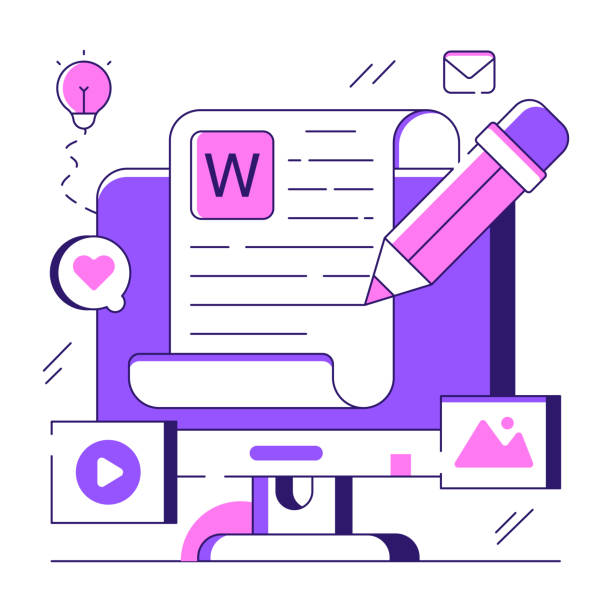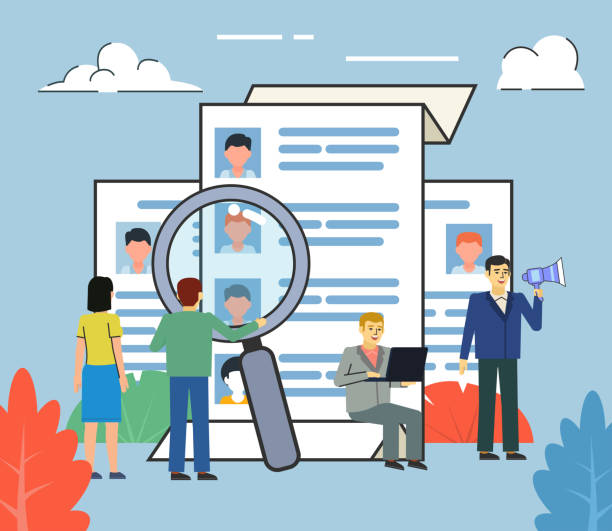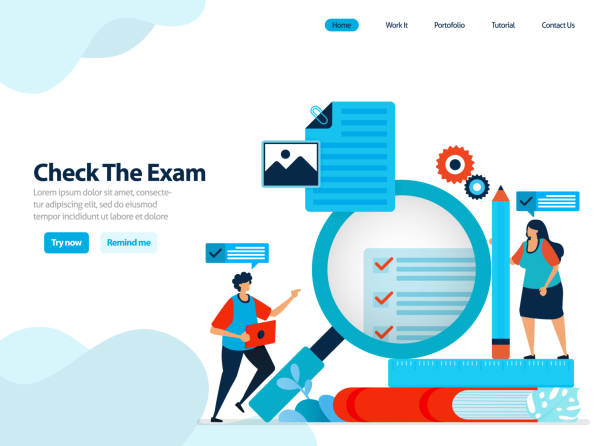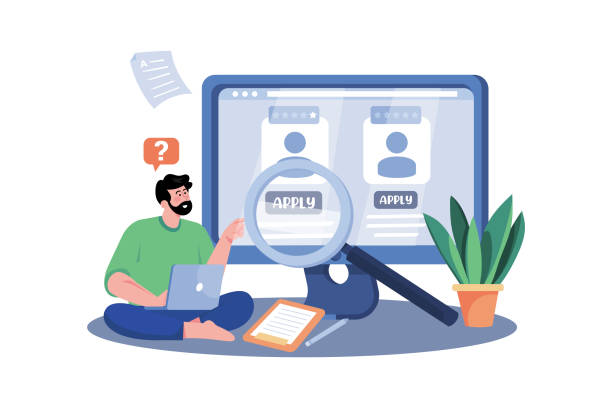Importance of Fast Website Design in Today’s Digital World

In the current era where speed is paramount, having a slow-loading website can mean losing countless customers and opportunities.
#Fast_Website_Design is no longer a competitive advantage, but a vital necessity.
Today’s users are impatient, and research shows that if a site doesn’t load in less than three seconds, many users abandon it.
This abandonment not only harms your conversion rates and sales but also negatively impacts your SEO and search engine rankings.
Search engines like Google consider site speed as one of the main ranking factors, and websites that offer a faster user experience have a better chance of being seen.
This topic is crucial from the perspective of Search Engine Optimization (SEO).
Furthermore, website loading speed directly affects User Experience (UX); a slow site can lead to frustration and users not returning, while a smooth and fast website provides an enjoyable experience and increases the likelihood of more interaction.
In this article, we will instructively and descriptively examine various aspects of fast website design.
Don’t forget that the ultimate goal of increasing speed is to improve your website’s efficiency and profitability.
Does your current site portray your brand’s credibility as it should? Or does it drive away potential customers?
Rasaweb, with years of experience in professional corporate website design, is your comprehensive solution.
✅ A modern, beautiful site tailored to your brand identity
✅ Significant increase in lead and new customer acquisition
⚡ Contact Rasaweb now for a free consultation on corporate website design!
Key Factors Affecting Website Loading Speed

Understanding the factors affecting website speed is the first step towards fast website design.
These factors can be divided into several general categories, each playing a significant role in the final loading time.
The first and perhaps most important factor is the quality of your hosting and server.
Inadequate hosting with limited resources and slow servers can nullify even the best design.
Using dedicated servers or VPS with sufficient resources and choosing a data center close to your target audience is crucial.
The second factor is the overall size of website files, including images, videos, CSS, and JavaScript files.
Reducing the size of these files without compromising quality is a specialized technique with a significant impact.
The third item is website coding.
Cluttered, unoptimized code and excessive use of plugins can severely reduce loading speed.
Cleaning up code, using lightweight frameworks, and avoiding unnecessary scripts are essential.
Additionally, enabling Caching and utilizing Content Delivery Networks (CDNs) for faster content delivery to users worldwide are other vital factors.
Understanding these factors will help you adopt an analytical and specialized approach to optimizing your website’s speed.
Choosing the Right Platform and Database Optimization

Choosing the right platform is the cornerstone of a fast and efficient website design.
There are various platforms for building websites, from Content Management Systems (CMS) like WordPress and Joomla to custom web development frameworks.
Each has its own advantages and disadvantages in terms of speed and flexibility.
WordPress is popular due to its high flexibility and countless plugins, but if not properly optimized, it can be slow.
In contrast, frameworks like React or Vue.js offer very fast performance for developing Single Page Applications (SPAs) and complex web applications, but require more technical knowledge.
For any platform, database optimization is crucial.
A cluttered and disorganized database can create serious bottlenecks in speed.
Compressing and cleaning tables, optimizing queries, and regularly removing unnecessary data are important steps in this regard.
Also, using optimized database systems like MySQL with appropriate settings or even migrating to newer databases like MariaDB or PostgreSQL can be effective in increasing speed.
This guidance and specialized approach helps you lay a strong foundation for high speed from the beginning.
| Platform | Speed Advantage | Speed Challenges | General Recommendation |
|---|---|---|---|
| WordPress | Fast installation and setup, powerful caching plugins | Dependency on heavy plugins and themes, need for continuous optimization | Suitable for blogs, small and medium businesses with precise optimization |
| Joomla | Internal caching tools, MVC framework | More complexity, smaller user base compared to WordPress | Suitable for corporate and more complex websites |
| Custom Development (React/Vue/Angular) | Extremely fast performance, full control over code | Longer development time, higher cost, need for specialized developers | Suitable for web applications and large platforms |
Optimizing Images and Multimedia Content

One of the biggest factors slowing down website speed is the large size of images and multimedia content.
In the process of fast website design, precise optimization of these elements is of high importance.
Images should be compressed before being uploaded to the website, without noticeably reducing their visual quality.
New image formats like WebP, developed by Google, can be up to 30% smaller than JPEG and PNG while still offering good quality.
Using these formats along with a fallback for older browsers is a smart solution.
The “Lazy Loading” technique is also highly recommended.
With this method, images and videos are only loaded when the user scrolls to the relevant section on the page, which significantly reduces the initial page load time.
Additionally, image dimensions should be appropriate for their display location on the website; loading a large image and then shrinking it with CSS only wastes bandwidth and server resources.
For videos, using external platforms like YouTube or Aparat and then embedding them is better than hosting them directly on your own server.
This part of the optimization requires an instructive and specialized approach to achieve the best results.
Is your company’s website as professional and trustworthy as it should be? With specialized corporate website design by Rasaweb, create an online presence that reflects your credibility and attracts more customers.
✅ Build a powerful and professional image for your brand
✅ Convert visitors into real customers
⚡ Get a free consultation now!
The Role of Optimized Coding and Lightweight Frameworks in Site Speed

The foundation of any website is its code.
Optimized and clean coding is the backbone of fast website design.
Developers must pay attention to the fact that even one extra or unnecessary line of code can affect loading speed.
Reducing the number of HTTP requests is a crucial principle.
This means combining CSS and JavaScript files (Minification and Concatenation) and removing white spaces, comments, and unnecessary code.
Using lightweight and efficient frameworks is also very important.
Some frameworks add a large amount of unnecessary code to the project, which can lead to a slow website.
Choosing frameworks that require minimal code to perform tasks (such as Alpine.js for small interactions or CSS frameworks like TailwindCSS that only load the necessary code) can have a significant impact on speed.
Additionally, optimizing JavaScript and placing it at the end of the HTML body, or using async and defer attributes, allows the main content of the website to load faster and delays script interactions.
This part of the optimization is entirely specialized and requires deep knowledge in web development.
Caching Techniques and Content Delivery Networks (CDN)

One of the most powerful methods for increasing website loading speed is the use of caching techniques and CDNs.
Caching means temporarily storing versions of your website’s content (such as images, CSS files, JavaScript, and even full pages) so they can be delivered faster on subsequent visits or to other users.
There are different types of caching: Browser Caching which stores files in the user’s browser; Server Caching which stores data on the server side for faster response; and Object Caching for storing database query results.
Properly enabling these caching mechanisms can significantly reduce loading time.
In addition to caching, using Content Delivery Networks (CDN) is also vital.
A CDN is a collection of servers distributed across various geographical locations.
When a user accesses your website, content is delivered from the CDN server closest to them, which reduces latency and significantly increases speed for users worldwide.
CDNs are especially essential for websites with global audiences and those with a lot of multimedia content.
This section of the article is descriptive and specialized, offering guidance for implementing these systems.
Site Speed Testing Tools and Methods, and Interpreting Results

After implementing fast website design techniques, it is essential to continuously measure and monitor your website’s performance.
Website speed testing tools provide valuable information about bottlenecks and areas for improvement.
Google PageSpeed Insights is one of the most widely used tools, providing performance scores for desktop and mobile versions and offering suggestions for improvement.
GTmetrix and Pingdom Tools are other popular tools that show more details about the loading time of each resource (such as images, CSS, JS) and the number of HTTP requests.
Correct interpretation of the results from these tools is very important.
A high score in PageSpeed Insights does not necessarily mean an excellent user experience; special attention should be paid to metrics such as First Contentful Paint (FCP), Largest Contentful Paint (LCP), and Cumulative Layout Shift (CLS), which indicate the actual user experience.
These metrics, known as Core Web Vitals, are considered by Google as SEO ranking factors.
This section is an instructive and analytical guide that helps you identify and resolve speed issues.
| Tool | Key Features | Report Type | Target Audience |
|---|---|---|---|
| Google PageSpeed Insights | Core Web Vitals scoring, Google suggestions | Concise and user-friendly, focus on SEO and UX | Marketers, developers, business owners |
| GTmetrix | Detailed Waterfall report, YSlow and PageSpeed Score | Highly detailed and technical, showing load time for each component | Developers, technical SEO specialists |
| Pingdom Tools | Waterfall chart, Performance Grade, test history | Understandable reports, overview of performance | Developers, website administrators |
The Impact of Responsive Design and User Experience on Perceived Speed

In today’s world, where a large portion of internet traffic comes from mobile devices, Responsive Design is not just a feature, but a requirement.
A website that is properly optimized for various devices can directly impact the user’s perceived speed.
Even if your website’s actual loading speed is high, if its design is inappropriate on mobile and page elements are not properly arranged, the user will feel slow and dissatisfied.
Therefore, a fast website design must always be accompanied by a Mobile-First approach.
User Experience (UX) optimization also goes beyond loading speed.
Elements such as an appealing User Interface (UI), easy Navigation, and clear Call-to-Action help users quickly access what they want, even if it takes a few more milliseconds to load.
Understanding that actual speed and perceived speed by the user are two different concepts is very important in overall website optimization.
This section of the article delves into these important aspects analytically and descriptively.
Research shows that 80% of customers trust companies with a professional website more. Does your current site inspire this trust?
With Rasaweb’s corporate website design services, permanently solve the problem of customer distrust and a weak online image!
✅ Create a professional image and increase customer trust
✅ Attract more sales leads and grow your business
⚡ Get a free consultation
Security and Maintenance Tips for Speed Stability

Website speed is not just about initial loading; it also depends on performance stability over time.
Regular maintenance and adherence to security tips play a vital role in maintaining the high speed of the website.
Cyberattacks, malware, and security breaches not only jeopardize your data but can also consume server resources and severely reduce website speed.
Therefore, using HTTPS protocol, regularly updating the content management system, plugins, and themes, and employing Web Application Firewalls (WAFs) and security tools are essentials.
Regular website scans to identify vulnerabilities and malware are also recommended.
In addition to security, regular maintenance includes data backup, periodic database optimization, and monitoring server resource consumption.
Reviewing server logs to identify errors and performance issues can help you resolve small problems before they become major ones.
Follow news related to new security vulnerabilities and take necessary actions promptly.
These guiding and informative measures not only ensure your security but also contribute to your website’s stability and optimal performance.
The Future of Fast Website Design and Upcoming Developments

The world of web is constantly evolving, and these developments directly impact fast website design.
New technologies such as HTTP/3, WebAssembly, and Service Workers are emerging, each having high potential to increase website speed and efficiency.
HTTP/3, using the QUIC protocol, provides a faster and more stable connection, which is particularly beneficial for mobile networks.
WebAssembly enables the execution of high-performance code in the browser and can offer unparalleled speed for complex web applications that require heavy processing.
Service Workers also provide offline capabilities and more precise control over network requests, leading to a smoother and faster user experience.
The future of web design is moving towards Progressive Web Apps (PWAs) and fully interactive and performance-driven websites.
These developments are thought-provoking and compel designers and developers to update their knowledge and skills.
To remain competitive, you must constantly be learning and adapting to new technologies.
This analytical and thought-provoking content helps you stay one step ahead and design a high-performance website for the future.
Frequently Asked Questions
| Question | Answer |
|---|---|
| What is fast website design? | A process for building a website that loads quickly and provides a smooth and optimized user experience. |
| Why is site speed important? | Increased user satisfaction, improved search engine ranking (SEO), reduced bounce rate, and increased conversion rate. |
| What factors affect site speed? | Page size, number of HTTP requests, image optimization, JavaScript and CSS codes, server speed, and caching. |
| How can site speed be measured? | Using tools like Google PageSpeed Insights, GTmetrix, Pingdom Tools. |
| How can site speed be increased? | Image optimization, file compression (CSS, JS, HTML), browser caching, reducing redirects, choosing suitable hosting. |
| Does fast website design mean low quality? | No, fast design means designing with a focus on speed and performance optimization, not reducing design or content quality. |
| What is the role of hosting in site speed? | The speed and quality of the hosting server directly impact the site’s response time and thus the loading speed. |
| How can images be optimized for speed? | Using appropriate formats (like WebP), compressing images without significant quality loss, specifying exact dimensions for images. |
| Can complex websites also be fast? | Yes, by using appropriate architecture, code optimization, and resource management, even complex websites can have high speed. |
| Is fast website design the same as Agile development? | No, fast website design focuses on the final outcome (a fast website), whereas Agile development is a methodology for project management and software development. |
And other services of Rasa Web Advertising Agency in the field of advertising
Smart Google Ads: An effective tool to increase website traffic with specialized programming.
Smart Customer Journey Map: Designed for businesses seeking online growth through SEO-driven content strategy.
Smart Direct Marketing: A new service for increasing digital branding through key page optimization.
Smart Marketing Automation: An innovative platform for improving customer acquisition with specialized programming.
Smart Content Strategy: A new service for increasing customer acquisition through specialized programming.
And over hundreds of other services in the field of internet advertising, advertising consultation, and organizational solutions
Internet Advertising | Advertising Strategy | Advertorials
Resources
Fast Website Design Tips, Increase Site Speed, Website Design for Online Businesses, Online Business Website Guide
? For your business to leap forward in the digital space, Rasaweb Afarin Digital Marketing Agency smooths your path to success with services such as custom website design, Search Engine Optimization (SEO), and professional social media management.
📍 Tehran, Mirdamad Street, next to Bank Markazi, Kazeroon Jonubi Alley, Ramin Alley, No. 6




